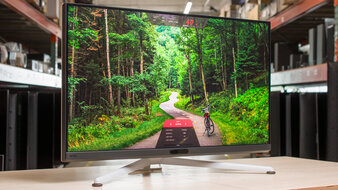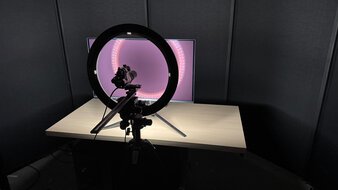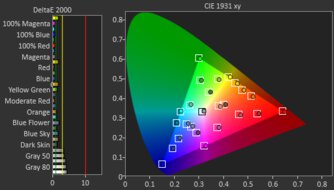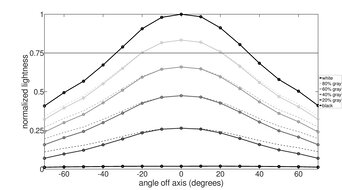If you're a professional photo editor or content creator, getting a proper monitor to work with can help you perfect your craft. While there are dedicated professional displays with perfect color accuracy, those tend to cost a lot, so the next best option is to get a consumer-level monitor that performs well enough even for serious photo editing. A monitor with a wide color gamut and a dedicated, accurate sRGB mode is useful if you don't want to pay more for calibration, allowing you to edit images properly. You may also want to consider the monitor's HDR performance, like its contrast and color volume, if you edit photos in HDR.
Besides the color accuracy, a high-resolution display lets you see images with a ton of detail, and you can also think about the size, but that's a personal preference. Getting a monitor with a USB hub, wide viewing angles, and good ergonomics also improves your workflow, especially if you need to multitask or often share your screen with someone else.
We've bought and tested more than 365 monitors, and below are our picks for the best monitors for photography and photo editing. See our recommendations for the best monitors for graphic design, the best monitors for video editing, and the best HDR monitors. If you need more than just a monitor, check out the best laptops for photo editing, the best cameras for photography, and to complete your setup, the best home printers.
Quick Look






We buy and test more than 30 monitors each year, with units that we buy completely on our own, without any cherry-picked units or samples. We put a lot into each unbiased, straight-to-the-point review, and there's a whole process from purchasing to publishing, involving multiple teams and people. We do more than just use the monitor for a week; we use specialized and custom tools to measure various aspects with objective data-based results. We also consider multiple factors before making any recommendations, including the monitor's cost, its performance against the competition, and whether or not it's easy to find.
-
Best Monitor for Photo Editing
 Editing9.3Color Accuracy9.2SDR Picture10HDR Picture9.4Brightness7.2Response Time9.9Size27"Pixel TypeQD-OLEDMax Refresh Rate240 HzSee all our test resultsNative Resolution3840 x 2160
Editing9.3Color Accuracy9.2SDR Picture10HDR Picture9.4Brightness7.2Response Time9.9Size27"Pixel TypeQD-OLEDMax Refresh Rate240 HzSee all our test resultsNative Resolution3840 x 2160The best monitor for photo editing that we've tested is the ASUS ROG Swift OLED PG27UCDM. It delivers remarkable picture quality for content creation. Although it's a gaming-focused monitor, the main advantage of getting this for photo editing is that its OLED panel displays deep, inky blacks in dark rooms without any haloing, which is great if you edit darker photos. It also comes with a remarkably accurate sRGB mode, which is actually more accurate than calibrating it with another picture mode. It even displays a wide range of colors in the Adobe RGB color space, but some colors are oversaturated in it.
Even if you want to edit content in HDR, it's an incredible choice as it displays a wide range of colors that also look vivid, so content looks realistic. Besides that, it has a high 4k resolution that delivers detailed images and sharp text, and its 27-inch screen is big enough for multitasking. However, you can also check out the similar ASUS ROG Swift OLED PG32UCDM if you want a bigger 32-inch screen. That said, because these monitors are OLEDs, they risk burn-in with constant exposure to the same static elements over time. If that's a concern for you, it's better to consider one of the LED monitors recommended below.
-
Best Upper Mid-Range Monitor For Photo Editing
 Editing8.2Color Accuracy8.8SDR Picture7.4HDR Picture7.6Brightness9.3Response Time8.3Size32"Pixel TypeIPSMax Refresh Rate144 HzSee all our test resultsNative Resolution3840 x 2160
Editing8.2Color Accuracy8.8SDR Picture7.4HDR Picture7.6Brightness9.3Response Time8.3Size32"Pixel TypeIPSMax Refresh Rate144 HzSee all our test resultsNative Resolution3840 x 2160If you're concerned about the risk of burn-in, then check out the BenQ MOBIUZ EX321UX, which tends to cost a bit less, too. There are some trade-offs of getting this monitor instead of the ASUS ROG Swift OLED PG27UCDM, as it doesn't have the same perfect blacks. While its Mini LED local dimming feature helps improve its contrast ratio, and blacks are deep enough for video editing, it's still not the same as an OLED, and there's haloing around bright objects. On the plus side, it displays a wide range of colors in most color spaces, including Rec. 2020, and it makes those colors look as vivid as on the ASUS.
One advantage of getting this over the ASUS is that it gets much brighter, which is ideal if you edit your content in a bright room. It also comes with a very accurate sRGB mode, and you can calibrate it to get even more accurate colors. Plus, like with the ASUS, its high 4k resolution delivers detailed images. It even comes with some useful productivity features, like a USB-C port with 65W of power delivery, and a fairly ergonomic stand that makes it easy to adjust in case you need to share your screen with someone else.
-
Best Mid-Range Monitor For Photo Editing
 Editing7.7Color Accuracy8.9SDR Picture6.9HDR Picture5.5Brightness7.3Response Time5.6Size27"Pixel TypeIPSMax Refresh Rate60 HzSee all our test resultsNative Resolution3840 x 2160
Editing7.7Color Accuracy8.9SDR Picture6.9HDR Picture5.5Brightness7.3Response Time5.6Size27"Pixel TypeIPSMax Refresh Rate60 HzSee all our test resultsNative Resolution3840 x 2160If you still find the BenQ MOBIUZ EX321UX too expensive, look into the ASUS ProArt Display PA279CRV. Like the BenQ, it has a 4k resolution with sharp text and image clarity, but it has a smaller screen. However, the main difference is that this monitor has a terrible local dimming feature and disappointing contrast, so blacks look gray, and there's distracting haloing around bright objects if you use the local dimming feature. This means it's a bad choice for editing darker content in dark rooms, but it still performs well for other types of photos, particularly in a bright room.
That said, the main advantage of getting this for photo editing is that it has an extremely accurate sRGB mode. Not only that, but it also has other picture modes for various color spaces that you may work with, including Adobe RGB, DCI-P3, and Rec. 2020. It even comes with a useful USB hub to which you can connect your devices. However, it lacks a KVM switch, which is disappointing if you have two computers connected to the monitor and you often need to switch between them. You can check out the Dell U2725QE if that's important to you, but it costs more and has worse accuracy before calibration.
-
Best Budget Monitor For Photo Editing
 Editing8.0Color Accuracy9.0SDR Picture7.9HDR Picture8.1Brightness8.9Response Time8.0Size27"Pixel TypeVAMax Refresh Rate180 HzSee all our test resultsNative Resolution2560 x 1440
Editing8.0Color Accuracy9.0SDR Picture7.9HDR Picture8.1Brightness8.9Response Time8.0Size27"Pixel TypeVAMax Refresh Rate180 HzSee all our test resultsNative Resolution2560 x 1440Should you be looking for the best monitor for photography editing and you're on a tight budget, the AOC Q27G40XMN is a great choice that offers a ton of value. Though it's different from the ASUS ProArt Display PA279CRV in a few ways because it has a lower 1440p resolution, so images aren't as detailed. It also has a less ergonomic stand, so you may have to consider getting a third-party mount if you need to constantly adjust the monitor. It isn't focused on photo editing the same way the ASUS is either, as it has fewer picture modes for various color spaces, but it still comes with a very accurate sRGB mode.
Besides these differences, the AOC has a few advantages over the ASUS. It uses Mini LED backlighting and has a great local dimming feature that improves its already-great contrast ratio. This means it's a great choice for editing content in dark rooms as it displays deep and inky blacks. However, using the local dimming feature locks the brightness to the max, which may be something to consider if you're sensitive to bright screens. It at least gets bright enough to fight glare in a well-lit room, though. If you can't find this monitor available in your region, the AOC Q27G3XMN is a very similar alternative that you can get. However, it has worse local dimming, and there are reports of some units having a red tint issue.
-
Best Cheap Monitor For Photo Editing
 Editing6.8Color Accuracy8.1SDR Picture5.8HDR Picture4.9Brightness7.1Response Time7.4Size27"Pixel TypeIPSMax Refresh Rate170 HzSee all our test resultsNative Resolution2560 x 1440
Editing6.8Color Accuracy8.1SDR Picture5.8HDR Picture4.9Brightness7.1Response Time7.4Size27"Pixel TypeIPSMax Refresh Rate170 HzSee all our test resultsNative Resolution2560 x 1440If you need a simple and cheap display for photo editing, like if you're just getting into the hobby for the first time and you're on a limited budget, check out the MSI G274QPF-QD. It usually costs less than the AOC Q27G40XMN, and it's worth getting when you can find it for cheap. Like the AOC, it's another 27-inch, 1440p display, so it delivers the same sharpness and details to the image. However, the main downside of getting this monitor is that it has a low contrast ratio and doesn't have a local dimming feature to further improve it. This means blacks look gray in dark rooms. It doesn't get as bright as the AOC either, but it's still fine to use with some lights around.
These are the trade-offs you should expect from such a cheap monitor, but it stands out against other entry-level models when it comes to photo editing. This is because it has a quantum-dot layer that displays a wide range of colors even in HDR color spaces, like Rec. 2020 and DCI-P3. It also comes with an accurate sRGB mode, but there are some white balance inaccuracies that you would need to calibrate if you need a perfectly accurate image.
Notable Mentions
-
Apple Studio Display:
The Apple Studio Display is a premium monitor that's ideal for photo editing on a Mac. This is because it has features that you can only use with macOS, like its accurate sRGB mode. It also has a very high 5k resolution for detailed images. However, it costs more than the ASUS ROG Swift OLED PG27UCDM and doesn't support HDR, so it's only worth getting if you have a Mac.
See our review -
Dell Alienware AW3225QF:
The Dell Alienware AW3225QF is a 4k QD-OLED with remarkable picture quality, similar to the ASUS ROG Swift OLED PG27UCDM. It's something to consider if you want a bigger 32-inch display, but it has a curved screen that may not be to everyone's liking.
See our review -
Dell S2725QC:
The Dell S2725QC is a 4k monitor that's cheaper than the ASUS ProArt Display PA279CRV. It's worth getting if the ASUS is just out of your price range. The Dell also comes with an sRGB mode, but it doesn't have dedicated modes for other color spaces, like the ASUS.
See our review -
ASUS ROG Strix XG27ACS:
The ASUS ROG Strix XG27ACS is a budget-friendly 1440p monitor. It's an alternative to the AOC Q27G40XMN if you aren't going to take advantage of its Mini LED local dimming. However, the ASUS doesn't get as bright and has a lower native contrast ratio.
See our review -
Dell P2425H:
The Dell P2425H is a basic and cheap monitor that costs less than the MSI G274QPF-QD. It's decent if you're on a very tight budget, but it lacks an sRGB mode, has a lower resolution, and has a smaller screen than the MSI.
See our review
Recent Updates
Oct 01, 2025:
We replaced the Acer Nitro XV275K P3biipruzx with the BenQ MOBIUZ EX321UX because the Acer is hard to find. We also replaced the ASUS ROG Strix XG27ACS with the AOC Q27G40XMN because the AOC has better overall picture quality. We added the MSI G274QPF-QD as the 'Best Cheap Monitor For Photo Editing' to give another option. In the Notable Mentions, we replaced the Xiaomi G Pro 27i with the Dell S2725QC and the ASUS ROG Strix XG27ACS.
May 29, 2025:
We replaced the Gigabyte AORUS FO32U2P with the ASUS ROG Swift OLED PG27UCDM and renamed it to the 'Best Monitor' for consistency with other recommendations. We added the Acer Nitro XV275K P3biipruzx and renamed the ASUS ProArt Display PA279CRV to the 'Best Mid-Range Monitor.' We also replaced the LG 27GP850-B/27GP83B-B with the ASUS ROG Strix XG27ACS, as the LG is hard to find. Lastly, we replaced the Dell U4025QW and the Dell U2723QE with the Xiaomi G Pro 27i, Dell Alienware AW3225QF, and the Dell P2425H in the Notable Mentions.
Feb 19, 2025:
We introduced a new format to the article and updated the text to reflect these changes. Additionally, we replaced the Gigabyte M27U's 'Best Mid-Range' category with the Gigabyte AORUS FO32U2P in the new 'Best OLED' category. Replaced the ASUS ProArt Display PA278CV with the LG 27GP850-B/27GP83B-B, as the LG has HDR support. Removed the Dell P2425H, as it doesn't have an sRGB mode.
Nov 01, 2024:
We moved the Apple Studio Display to the Notable Mentions because it's an expensive monitor that works best with macOS. We replaced the Dell S2722QC with the Gigabyte M27U because it has better accuracy. We also added the Dell P2425H as the 'Best Cheap Monitor.' Lastly, we replaced the AOC Q27G3XMN with the Dell Alienware AW3225QF in the Notable Mentions.
Aug 16, 2024: We replaced the Dell S2721QS with the ASUS ProArt Display PA278CV as the ASUS has better color accuracy. In Notable Mentions, we replaced the Apple Studio Display XDR and the ASUS VG246H with the AOC Q27G3XMN to be more representative of the current market.
All Reviews
Our recommendations are based on what we think are the best monitors for editing photos and other types of media creation currently available. They are adapted to be valid for most people in each price range. The rating is based on our review, factoring in price and feedback from our visitors.
If you would prefer to make your own decision, here is the list of all of our monitor reviews. Be careful not to get too caught up in the details. Most monitors are good enough to please most people, and the things we fault monitors on are often not noticeable unless you really look for them.















